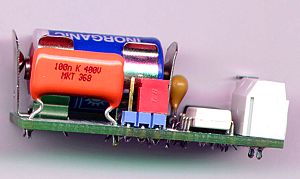Other pages in this archive: Slave:
Questions | Slave: troubleshooting |
slave2005-1a.pdf | SLV023_kitcheck.pdf |
slv023-BOM-1v1-A.pdf
i) Features
- Very high sensitivity
The line-of-sight triggering range is around 1200m with a
gun of GN 30m @ 100ASA. This high sensitivity allows the slave to "see" around
corners in dark passages.
- Infrared sensitive for
use with "dark" flashguns
It is useful to trigger a slave
from a flashgun mounted on the camera, but you might not want the foreground to
be illuminated. The visible light can be blocked using an infrared filter.
Flashguns generate a significant amount of infrared light. This is detected by
the slave and triggers the main flash.
- Usable underwater
The photodiode is sensitive to visible light as well as
infrared. For underwater use, where infrared is attenuated, the unit works when
other commercial units (which are only sensitive to infrared) will fail. (Note:
the Firefly unit is only infrared-sensitive, so its performance
underwater is limited)
- Not sensitive to
caplamp beams
The slave is triggered by the short, sharp,
bright pulse from an electronic flashgun. It should not respond when a caplamp
is shone at it.
- Not adversely affected
by ambient light
Cavers will usually be operating the slave
unit in the dark, so the question of ambient light does not arise. However, if
you want to operate it in conditions where there is some light you need to know
how its performance is affected. The response has been tailored to work in
ambient light as a fill-in flash. It will trigger when a near-instantaneous
pulse of light exceeds the general light level by around 3½%. In terms
of photographic "stops" this is about 1/20 stop.
- Triggered by, and will
fire flashbulbs
The unit is designed to be triggered by the
sharp pulse from an electronic flashgun, and to ignore the much slower changes
in light level caused by a wavering caplamp beam. Flashbulbs come somewhere in
between. As it stands, the unit can usually be triggered by a flashbulb. The
revised slave unit, now available has been enhanced to allow it to fire
flashbulbs more reliably than the previous unit. A combined slave and bulb
firer is also available.
- Compact design
The unit will fit inside a translucent 35mm film container.
It could, perhaps, be placed inside the casing of a flashgun, and operated from
the flashgun's own batteries. The size of the circuit board in the current
version is 46mm x 23mm, but it can be trimmed to a smaller size if the on-board
battery is not required..
- Low current
consumption: life of 4 years or 10,000 flashes
One 3.6V
lithium cell (size ½AA) provides enough energy for 10,000 flashes, and
will run the unit for 4 years. Since this is comparable with the shelf-life of
the batteries an on/off switch is not required. This, in turn, means that a
simpler connector (which doesnt have to double as a switch) can be used.
Alternatively, the built-in opto-isolation means that the unit can be run from
the flashgun batteries themselves.
- Fit a
battery
Fit a 3.6V lithium cell (size ½AA; 25mm in
length x 15mm diameter), making sure that you observe the polarity. Lithium
cells are available from photographic and computer stores; the battery is used
for memory backup in some computers. A typical part is the Sonnenschein
SL350/S, or the Tadiran SL750/S. This is a 3.6V, 1.1Ah Lithium Thionyl Chloride
cell, available, in the UK, from Farnell
Electronic Components, stock number 118-7264. alternatively,
Maplin Electronics stock a Maxell
battery, ER3S_TC, stock code QE49D. Note: those stock codes may be
replaced by more recent ones; you may have to do a web search.
- Wire a
connector
The slave unit is not supplied with a 'hot-shoe'
connector, but a phono (RCA) plug and lead. This is connected to the circuit
board via screw terminals, so you can wire your own connector and lead if you
wish.
 Select the link
position
Select the link
position
Push the programming link onto one pair of the
three programming pins. Referring to the photo, position 1 (as shown) is to the
right (terminal end of board), and position 2 is to the left (battery end of
board). Position 1 works with most flashguns, and flashbulbs. Position 2 works
with all flashguns, but not with flashbulbs.
 Select the link
position
Select the link
position